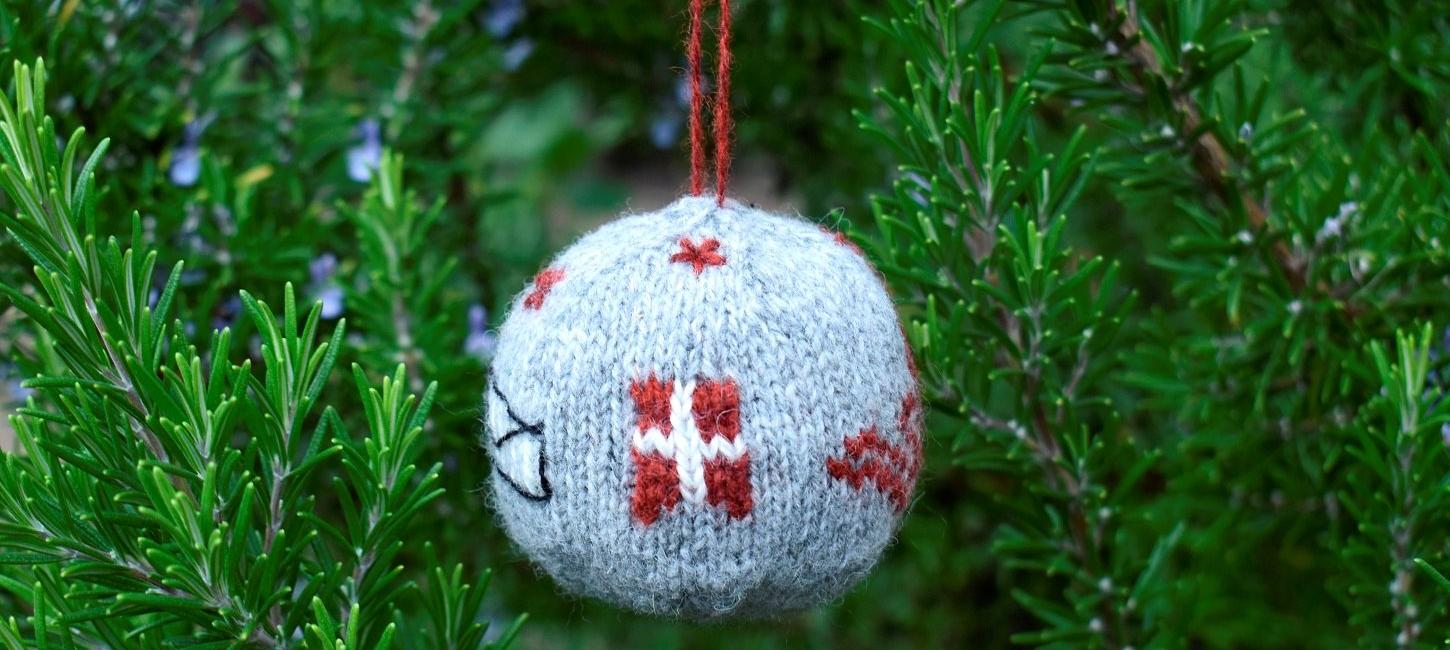
The Christmas ball 2023
The Christmas ball 2023 is knitted with four motifs, and is locally produced and organic.
Four unique designs adorn this year's sustainable Christmas ornament, handcrafted by Ulrikkagarn in Nyborg.
When Christmas comes to Nyborg, it once again becomes possible to hang a truly unique Christmas bauble on your tree, designed specifically for Nyborg. But this year, there's something different. Instead of being made of painted glass, the ornament is knitted, with the story woven into carefully selected patterns. Designed by Lise-Lotte Jensen, owner of Ulrikkagarn in Nyborg, with a special focus on communicating history through knitting, each ornament is knitted by either Lise-Lotte herself or her 81-year-old collaborator, Lone from Rudkøbing.
'We are delighted to once again offer our guests a truly unique Nyborg Christmas ornament,' says Mette Ladegaard Thøgersen, Head of Department at Nyborg Castle and Cultural History Department. 'This time, however, the ornament is designed with a broader societal perspective, focusing on sustainability and ecology. The ornament also reflects the current great interest in handicrafts and Danish design. A big thank you to Lise-Lotte from Ulrikkagarn for taking on the challenge of both designing and knitting this year's ornament.'
An ecological and sustainable Christmas ornament
In this era of great focus on climate and sustainability, a knitted Christmas ornament is entirely in keeping with the spirit of the times. Each ornament is handcrafted, the yarn is organic and GOTS* certified, and sourced from a Danish supplier.
'The red yarn is plant-dyed in Nyborg, using natural dyes such as madder root, redwood, and cochineal. The other colors, gray and white, are GOTS certified. The black embroidery yarn is sustainably produced and made from mulesing-free merino wool, ensuring animal welfare in the production of the Christmas ornament,' says Lise-Lotte Jensen from Ulrikkagarn.
Other truly beautiful examples of sustainable Christmas decorations can currently be seen at this year's Christmas exhibition at Toldboden in Kerteminde. Here, examples of the cultural history of the Christmas tree are on display, and Lise-Lotte has provided decorations for the museum's vision of a sustainable Christmas tree.
Design and choice of motifs
The ornament is made of gray wool with four different patterns. Three of the patterns have a special connection to Danish Christmas, and the fourth pattern is a very special tribute to Nyborg.
'Each pattern on the ornament has a special meaning,' says Lise-Lotte Jensen. 'The letter, for example, is a symbol of thinking about others. In the past, we sent countless Christmas greetings by post, and it was a nice way to reach out to family and friends. In the Christmas card, we told about the year that had passed and wished the recipient a Merry Christmas and a Happy New Year. Many people probably also remember buying beautiful Christmas cards and Christmas seals from UNICEF and other charitable organizations, thereby supporting them during Christmas.'
Another motif is the Danish flag. It symbolizes both Danish culture and history, and flags with the Danish flag have adorned Christmas trees for many years. The ornament also features a braided heart. This connects both to the Danish Christmas and to H.C. Andersen, who is believed to have braided the first heart. A little twist to the story is that the famous author also had a local connection. H.C. Andersen visited Regisse Kilde in Frørup on his way to Glorup Manor, and he was also often a guest at Lykkesholm Castle near Ørbæk.
The last pattern is a symbol of Margaret I. This naturally points back to Nyborg's royal past, and it is precisely Margaret who was chosen because she was selected as regent for this year's Danehof.
*GOTS certification is a guarantee that textiles are produced in an environmentally friendly and socially responsible manner. GOTS requires that at least 70% of the product consists of certified organic fibers, and that all chemicals, such as dyes, meet specific environmental requirements.
*Mulesing is a method used in Australia, one of the largest producers of merino wool, where skin folds are cut from the backsides of merino sheep to prevent flies from laying eggs there, often while the sheep is still a lamb. This is often done without anesthesia, and it takes two to four weeks for the wound to heal.